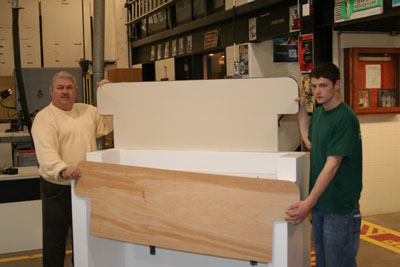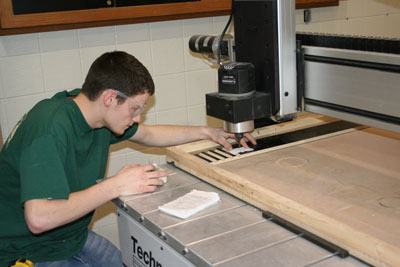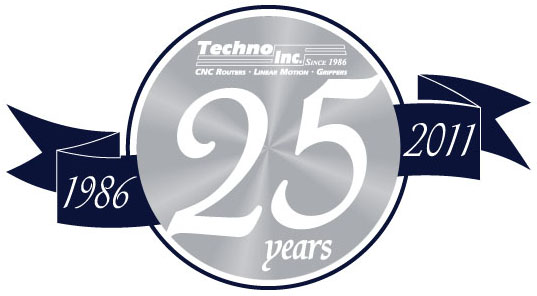|
Vocational School Helps Students Land High-Paying Jobs as CNC Cabinetmakers
Wages of entry-level carpenters have been driven down along with many other nonprofessional occupations in recent years. If carpenters stay in the field, they typically advance slowly over the years until they reach the level of master craftsman perhaps by the time they reach 40 years of age. But technology is having a major impact on the carpentry field. Computerized numerical control (CNC) machines now provide the ability for people with computer skills but far fewer years of carpentry experience to produce complicated parts faster and to a higher level of accuracy than the most skilled craftsmen.
 The Mahoning County Career and Technical Center, Canfield, Ohio, is riding this wave by providing a program that teaches students carpentry skills as well as how to program and operate CNC machines. The students who have completed this program can, when they graduate, produce work on the level of a skilled craftsman and so can demand substantially higher wages than other graduates. Of the school’s graduates to date in its CNC program, every one has either taken or turned down jobs in the carpentry field at wages approximately twice the level of entry level carpenters without CNC skills. The program’s advisory committee has been instrumental in initiating changes in the program’s curriculum. “There are too many carpenters out there framing houses, and they are undercutting each other on price so much that it doesn’t pay to keep training these kids in that area”, said one advisory member. “There is a greater need for finish carpenters and custom cabinetmakers”. “CNC work in a cabinet shop, now that’s where the money and opportunities are,” he also stated. The Mahoning County Career and Technical Center, Canfield, Ohio, is riding this wave by providing a program that teaches students carpentry skills as well as how to program and operate CNC machines. The students who have completed this program can, when they graduate, produce work on the level of a skilled craftsman and so can demand substantially higher wages than other graduates. Of the school’s graduates to date in its CNC program, every one has either taken or turned down jobs in the carpentry field at wages approximately twice the level of entry level carpenters without CNC skills. The program’s advisory committee has been instrumental in initiating changes in the program’s curriculum. “There are too many carpenters out there framing houses, and they are undercutting each other on price so much that it doesn’t pay to keep training these kids in that area”, said one advisory member. “There is a greater need for finish carpenters and custom cabinetmakers”. “CNC work in a cabinet shop, now that’s where the money and opportunities are,” he also stated.
Mahoning County Career and Technical Center offers a two-year Carpentry & Cabinetmaking program that focuses on two major areas: residential/commercial carpentry and cabinetmaking. Upon successful completion of both phases of the program, students can apply for apprenticeship positions in the building trades or directly enter the building trade’s field. In the residential/commercial carpentry area, all aspects of residential home building and light commercial carpentry are taught, as well as computerized drafting and estimating. In the cabinetmaking segment, all phases and most types of cabinetmaking are taught. Students learn to design, build and finish cabinets. Both wooden face frame and laminate cabinets are built. Carpentry and cabinetmaking apprenticeships are available.
Adding CNC to the carpentry program
John Panella, who teaches this program, said that about five years ago local cabinet shops began purchasing CNC machines in an effort to improve their productivity and quality. For those who aren’t familiar with this technology, CNC machines automate the work of conventional power tools by using computer-generated commands to move the cutting surface with far more precision than could be achieved by even the most experienced craftsman. Getting the most out of these machines requires considerably different skills than are required to use power tools.
 Rather than controlling the tool with their hands, the student must learn how to create a model of the part they want to make on the computer in three dimensional space. Once they have accomplished this task, they can easily convert their model into a CNC program that will cut out the part to a higher level of accuracy than the most experienced craftsman can achieve. In addition, the machine will build as many parts as desired without requiring any attention on the parting of the operator except for loading the raw stock and pressing the start button. Rather than controlling the tool with their hands, the student must learn how to create a model of the part they want to make on the computer in three dimensional space. Once they have accomplished this task, they can easily convert their model into a CNC program that will cut out the part to a higher level of accuracy than the most experienced craftsman can achieve. In addition, the machine will build as many parts as desired without requiring any attention on the parting of the operator except for loading the raw stock and pressing the start button.
The owners of several local cabinet shops told Panella that they were having great difficulty finding people that could program CNC machines. Panella made the decision to elevate the Carpentry & Cabinetmaking program to increase its emphasis on technology in general and CNC in particular. He spoke to five local cabinet shops that were not using CNC machines and discovered they were in such dire need of skilled programmers and operators that they stated that they would purchase a CNC machine for their shop if Panella could train students to program and operate the CNC machines. “Most of us are too old and don’t want to take time to learn about computers, and too busy to stop overseeing our shops to learn”, said one shop owner of 32 years.
Picking the right machine
The decision of which machine to purchase was an important one. While the basic skills required to program any CNC machine are the same, there are subtle distinctions between the different machines and programming software. Panella’s goal was to prepare his students to move as rapidly as possible into high-paying jobs so he consulted with the owners of the cabinet shops to get their ideas on which machine his students should learn to maximize their value in the workplace. The companies had all researched the market prior to purchasing their machines and the majority had selected Techno machines from Techno-Isel, New Hyde Park, New York. Panella looked closely at the Techno machine and felt that its wide use in industry would make it the ideal learning platform.
“Techno machines are designed with just the right mix of features for small and medium sized cabinetmakers,” Panella said. “For example, they have ball screws on all three axes and closed loop servo systems.” These are the type of features required to produce premium quality cabinets at a very competitive price. Techno machines also equip shops to handle many jobs that are impractical to produce by hand because they would take too long, such as complicated three dimensional contours. Yet a machine with a 4 foot by 8 foot table and all the required software costs less than $20,000. It’s no wonder that the majority of cabinet shops in this area are using Techno machines. In order to equip our students to move as quickly and as seamlessly into the workforce as possible, we felt it was important to teach them on the same machines they would be using in their job.”
Integrating CNC instruction into the program
Panella integrated instruction on the CNC machine into the Carpentry & Cabinetmaking program. The CNC section of the course is an option that not all students participate in, partly because it demands relatively high computer skills combined with reading comprehension. “We teach the students to program the machine using a software package that is popular among cabinet shops,” he said. “The most difficult task is defining the geometry of the part.” It is necessary to think through every detail of the part in order to fully understand its geometry. Then the students can use the software to construct the geometry on the computer, first in the form of lines, then surfaces, and finally as 3D volumes.”
For example, Panella often gives his students the assignment of producing a 12 inch deep, 8 foot high cabinet starting with 60 inch wide and 108 inch long Melamine board. The students begin by creating cubes to represent the walls of the cabinet. Then they add dadoes to their model every twelve inches by subtracting volumes from the walls to produce the two sides of the cabinet. It’s important to note that once they create the program they add it to their library so they can reuse it whenever they need it. Then the students download the program to the machine, clamp the board to the machine table, hit the start button, and cut out their first cabinet. It’s a very simple design but the accuracy is better than could be achieved by the most experienced master craftsmen. And the students have done it with only a few weeks of instruction as opposed to a few decades that are normally required to become an experienced cabinetmaker.
Moving on to more advanced projects
Later in the course, the students get the opportunity to program more complicated high-end designs such curved cabinets and woodwork that are sometimes found in expensive custom homes. Curved woodwork is very difficult to produce by hand with a router and a template. For example, assuming the curve of the cabinet is concave, interior parts such as the box must have one radius while parts farther out such as the door must have a larger radius. Students can leverage software features to program curved cabinets and other complex geometry in much less time. “The cabinetmaking professional is in the midst of a revolution because there is no limit to the designs that you can produce with a CNC machine,” Panella said. “It’s amazing what our graduates can do after they have had a year or two of on-the-job experience.”
Panella said the students that participate in this program have an easier time finding their first job and earn more money than those who do not. “In the last four years, 15 students have completed this phase of the program,” he said. “Most of them received job offers of $10 per hour and higher while they were still in school.” When they graduated, all of them received full-time job offers from local cabinet shops. Ten of them are still in the area working in the field and most have seen their income steadily increase. The others have accepted opportunities in other fields. In some cases, their CNC training helped prepare them for these non-carpentry jobs. For example, one of my students is now utilizing his CNC knowledge as an apprentice pattern maker in a local foundry. It’s getting pretty obvious that CNC is the future of the cabinetmaking business and our graduates are equipped to play a major role.”
|



 Affordable Precision Educational CNC Routers
Affordable Precision Educational CNC Routers Techno is celebrating over 25 years of CNC technology
expertise. Our Educational sector provides industrial quality products
at educational prices with a network of award-winning Educators. We can
provide CNC Curriculums, CNC Projects, Technical Information and
Packages for any educational classroom.
Techno is celebrating over 25 years of CNC technology
expertise. Our Educational sector provides industrial quality products
at educational prices with a network of award-winning Educators. We can
provide CNC Curriculums, CNC Projects, Technical Information and
Packages for any educational classroom. The Mahoning County Career and Technical Center, Canfield, Ohio, is riding this wave by providing a program that teaches students carpentry skills as well as how to program and operate CNC machines. The students who have completed this program can, when they graduate, produce work on the level of a skilled craftsman and so can demand substantially higher wages than other graduates. Of the school’s graduates to date in its CNC program, every one has either taken or turned down jobs in the carpentry field at wages approximately twice the level of entry level carpenters without CNC skills. The program’s advisory committee has been instrumental in initiating changes in the program’s curriculum. “There are too many carpenters out there framing houses, and they are undercutting each other on price so much that it doesn’t pay to keep training these kids in that area”, said one advisory member. “There is a greater need for finish carpenters and custom cabinetmakers”. “CNC work in a cabinet shop, now that’s where the money and opportunities are,” he also stated.
The Mahoning County Career and Technical Center, Canfield, Ohio, is riding this wave by providing a program that teaches students carpentry skills as well as how to program and operate CNC machines. The students who have completed this program can, when they graduate, produce work on the level of a skilled craftsman and so can demand substantially higher wages than other graduates. Of the school’s graduates to date in its CNC program, every one has either taken or turned down jobs in the carpentry field at wages approximately twice the level of entry level carpenters without CNC skills. The program’s advisory committee has been instrumental in initiating changes in the program’s curriculum. “There are too many carpenters out there framing houses, and they are undercutting each other on price so much that it doesn’t pay to keep training these kids in that area”, said one advisory member. “There is a greater need for finish carpenters and custom cabinetmakers”. “CNC work in a cabinet shop, now that’s where the money and opportunities are,” he also stated.  Rather than controlling the tool with their hands, the student must learn how to create a model of the part they want to make on the computer in three dimensional space. Once they have accomplished this task, they can easily convert their model into a CNC program that will cut out the part to a higher level of accuracy than the most experienced craftsman can achieve. In addition, the machine will build as many parts as desired without requiring any attention on the parting of the operator except for loading the raw stock and pressing the start button.
Rather than controlling the tool with their hands, the student must learn how to create a model of the part they want to make on the computer in three dimensional space. Once they have accomplished this task, they can easily convert their model into a CNC program that will cut out the part to a higher level of accuracy than the most experienced craftsman can achieve. In addition, the machine will build as many parts as desired without requiring any attention on the parting of the operator except for loading the raw stock and pressing the start button.